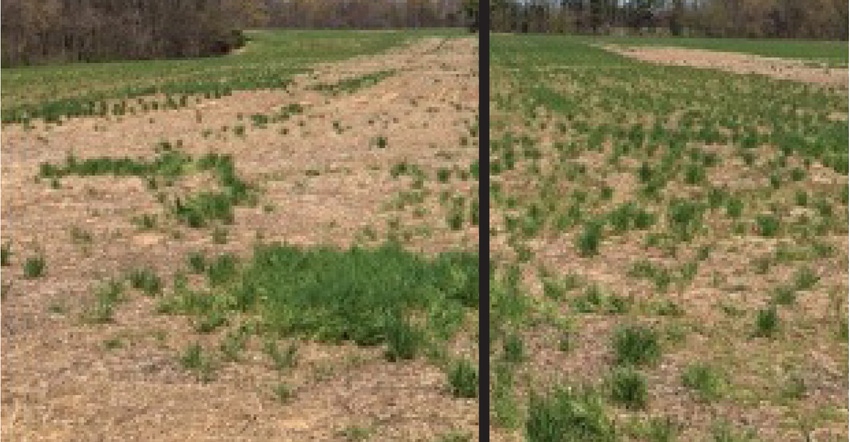November 11, 2021

Sponsored Content
Utilizing a broad-spectrum fall (post-harvest) burndown can help reduce the soil weed seed bank by controlling winter annual and perennial weeds. It can also offer several auxiliary benefits to row crop fields. Beyond the goal of reliable weed control, a fall herbicide application has many benefits. It can reduce host plants for pathogens such as soybean cyst nematode (SCN), over-wintering insects, and even diseases in warmer climates, and it can help maintain soil moisture in drought-stressed/arid climates. Fall herbicide applications also enable fields to be planted as soon as weather conditions allow; and help soil warming and drying in the spring, especially no-till fields. The net result is a more uniform crop emergence with fewer abiotic and biotic stressors.
Fall burndown applications start with identifying problem weeds for each field. Cool-season (winter) annuals such as marestail, purple henbit, and Italian ryegrass are the primary target of these applications. Still, depending on the geographic location of the field, the target weeds could change. These applications begin with a non-selective herbicide, such as paraquat or glyphosate, plus a residual herbicide to create a barrier for germinating seeds.
When targeting broadleaf weeds like marestail that can germinate over a long period, it is important to utilize a residual barrier that is effective on small-seeded broadleaves. Some Group 14 herbicides like flumioxazin will accomplish this while also adding extra burndown power to the non-selective herbicide it is mixed with. If the target weed is a grass species, such as Italian ryegrass, a Group 15 herbicide will be needed to provide a residual barrier.
In this scenario, 40 fl. oz. of paraquat was mixed with 16 fl. oz. of S-metolachlor and was applied on October 24 in West Tennessee. This application targeted volunteer wheat and Italian ryegrass. If glyphosate-resistant species are present, a secondary site of action will be needed to successfully remove the target pest. For example, a Group 4 herbicide such as 2,4-D or dicamba can be utilized in combination with glyphosate to target marestail. Group 5 herbicides, like metribuzin, can also be used to provide burndown power and offer a residual barrier.
Beck’s Practical Farm Research (PFR)® team in Southern Illinois evaluated fall versus spring burndown programs. This study aimed to compare weed control between the two programs and find the most effective ways for the two programs to work in unison. For example, if a fall burndown is applied, can a less expensive burndown or fewer products in the spring, such as Gramoxone® or Roundup plus 2,4-D, be used to help save on costs? Ultimately, the answer was yes in this study, but the growing environment and weed species present determine efficacy by location and year.
KEYS TO FALL BURNDOWN APPLICATIONS
Timing: Apply to emerged weeds after harvest through early spring. Avoid below freezing temperatures and frozen ground.
Adjuvants: When using nonresidual herbicides, an adjuvant is recommended. Some glyphosate products have a built-in adjuvant and may not require an additional surfactant.
Product Selection: Metribuzin will provide both burndown and residual activity. However, the residual value won’t be as great as with some Group 2, 14, or 15 products.
Application Restrictions: Be cognizant of plant back considerations and maximum use rates, especially if a pre-plant burndown and/or a post-plant pre will also be used. For example, if a flumioxazin product will be used in the spring, a different product should be applied in the fall.
Fall burndown applications are a smart management strategy that provides long-lasting weed control for cleaner, warmer seedbeds the following spring.
Beck's - Farmers At Heart® - revolutionized the customer seed buying experience by remaining true to a foundation built on faith, family, and farming. Founded in 1937, Beck's appreciates the farmers who have helped them become the largest family-owned retail seed company and the third largest seed brand in the United States. The Beck family is now in its fifth generation of family members who work in the business to honor God and help farmers succeed. The Beck family and team of employees help farmers achieve success from generation to generation through authentic customer experiences, product diversity, seed quality, and performance. With a home office located in Atlanta, Ind., Beck's serves farmers throughout the Midwest and Mid-South. For more information about Beck's Superior Hybrids, Inc., visit www.beckshybrids.com.
About the Author(s)
You May Also Like




